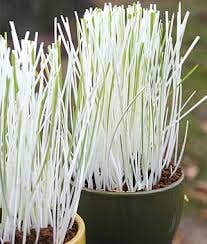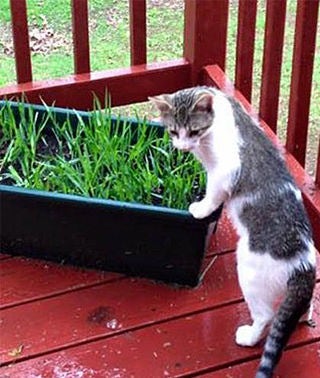
Sowing Cat Grass Seed Indoors
- To grow cat grass as a houseplant, sow indoors at any time.
- Sow seeds ¼ inch deep in seed starting formula in the container where the plants will grow.
- Keep the soil moist at 70 degrees F
- Seedlings emerge in 7-14 days
- As soon as seedlings emerge, provide plenty of light on a sunny windowsill or grow seedlings 3-4 inches beneath fluorescent plant lights turned on 16 hours per day, off for 8 hours at night. Raise the lights as the plants grow taller. Incandescent bulbs will not work for this process because they will get too hot. Most plants require a dark period to grow, do not leave lights on for 24 hours.
Sowing Cat Grass Directly in the Garden
- Sow cat grass outdoors in spring after all danger of frost has passed in average soil in full sun.
- Remove weeds and work organic matter into the top 6-8 inches of soil; then level and smooth.
- Sow seeds ¼ inch deep in rows 1 inch apart.
- Firm lightly and keep evenly moist.
- Seedlings emerge 7-14 days.

How to Grow
 Keep weeds under control during the cat grass growing season. Weeds compete with plants for water, space and nutrients, so control them by either cultivating often or use a mulch to prevent their seeds from germinating.
Keep weeds under control during the cat grass growing season. Weeds compete with plants for water, space and nutrients, so control them by either cultivating often or use a mulch to prevent their seeds from germinating.- For best results, water just as soil surface dries.
- Re-sow often to maintain months of vibrant grass.
- Trim back to 1 inch every second week to promote fresh growth.
- Cat grass usually re-grows quickly several times after being nibbled.
- Monitor grass for pests and diseases. Check with your local Cooperative Extension Service for pest controls recommended for your area.
Cat Grass Harvesting and Preserving Tips
- Pets may graze plants at will.
- People can make smoothies with young green leaves cut at 1 inch from the ground as needed.
Growing Cat Grass Herbs in Containers
Cat Grass Common Disease Problems
Damping Off: This is one of the most common problems when starting plants from seed. The seedling emerges and appears healthy; then it suddenly wilts and dies for no obvious reason. Damping off is caused by a fungus that is active when there is abundant moisture and soils and air temperatures are above 68 degrees F. Typically, this indicates that the soil is too wet or contains high amounts of nitrogen fertilizer. Burpee Recommends: Keep seedlings moist but do not overwater; avoid over-fertilizing your seedlings; thin out seedlings to avoid overcrowding; make sure the plants are getting good air circulation; if you plant in containers, thoroughly wash them in soapy water & rinse in a ten per cent bleach solution after use.
Nematodes: Microscopic worm-like pests that cause swellings (galls) to form on roots. Plants may wilt or appear stunted. Burpee Recommends: Do not plant into infested soil. Try planting ‘Nema-Gone’ marigolds around your plants in the garden. Grow in containers.
Powdery Mildew: This fungus disease occurs on the top of the leaves in humid weather conditions. The leaves appear to have a whitish or greyish surface and may curl. Burpee Recommends: Avoid powdery mildew by providing good air circulation for the plants by good spacing and pruning. Contact your Cooperative Extension Service for fungicide recommendations.
Rust: A number of fungus diseases that cause rust colored spots on foliage. Burpee Recommends: Remove infected plants. Contact your Cooperative Extension Service for recommendations.
Smut: This fungus causes streaks on leaves that mature into black powdery spores. The fungus stunts the growth of the plants. The disease lives in the soil for several years. Burpee Recommends: Rotate crops and do not plant in the same area for at least three years. Encourage rapid growth with watering and fertilizer to get plants past the susceptible stage. Some fungicides are effective, Check with your Cooperative Extension Service for recommendations.
Cat Grass Common Pest Problems
Aphids: Greenish, red, black or peach colored sucking insects can spread disease as they feed on the undersides of leaves. They leave a sticky residue on foliage that attracts ants. Burpee Recommends: Introduce or attract natural predators into your garden such as lady beetles and wasps who feed on aphids. You can also wash them off with a strong spray, or use an insecticidal soap.
Armyworm: Holes in leaves can be singular or clumped together. Leaves can become skeletonized. Egg clusters may be evident on foliage with a cottony or fuzzy appearance. Young larvae are pale green and adults are darker with a light line along the sideand pink underside. Burpee Recommends: Introduce natural enemies to the area.
 Slugs: These pests leave large holes in the foliage or eat leaves entirely. They leave a slime trail, feed at night and are mostly a problem in damp weather. Burpee Recommends: Hand pick, at night if possible. You can try attracting the slugs to traps either using cornmeal or beer. For a beer trap, dig a hole in the ground and place a large cup or bowl into the hole; use something that has steep sides so that the slugs can’t crawl back out when they’re finished. Fill the bowl about ¾ of the way full with beer, and let it sit overnight. In the morning, the bowl should be full of drowned slugs that can be dumped out for the birds to eat. For a cornmeal trap, put a tablespoon or two of cornmeal in a jar and put it on its side near the plants. Slugs are attracted to the scent but they cannot digest it and it will kill them. You can also try placing a barrier around your plants of diatomaceous earth or even coffee grounds. They cannot crawl over these.
Slugs: These pests leave large holes in the foliage or eat leaves entirely. They leave a slime trail, feed at night and are mostly a problem in damp weather. Burpee Recommends: Hand pick, at night if possible. You can try attracting the slugs to traps either using cornmeal or beer. For a beer trap, dig a hole in the ground and place a large cup or bowl into the hole; use something that has steep sides so that the slugs can’t crawl back out when they’re finished. Fill the bowl about ¾ of the way full with beer, and let it sit overnight. In the morning, the bowl should be full of drowned slugs that can be dumped out for the birds to eat. For a cornmeal trap, put a tablespoon or two of cornmeal in a jar and put it on its side near the plants. Slugs are attracted to the scent but they cannot digest it and it will kill them. You can also try placing a barrier around your plants of diatomaceous earth or even coffee grounds. They cannot crawl over these.
Whitefly: These are small white flying insects that often rise up in a cloud when plants are disturbed or brushed against. Burpee Recommends: They are difficult to control without chemicals. Try hot pepper wax or insecticidal soap. Check with your Cooperative Extension Service for pesticide recommendations.
Wireworms: These insects live in the soil and kill seedlings by girdling their stems at the soil line, bore into stems, roots and tubers. They may be found around the stems in the soil are and ¼ to ¾ inch long, thin, yellow brown worms with a shiny skin. The adults are called click beetles, and are about 1/3 inch long, reddish brown with a hard shell. Burpee Recommends: Rotate crops. Check with your Cooperative Extension Service for pesticide recommendations which must be applied prior to planting.
FAQ
What is the Latin name of cat grass? Cat grass is oat grass, Avena sativa.
Is cat grass an annual or perennial? Cat grass is an annual.
Why should I plant cat grass? Cats and dogs have a tendency to eat turf grasses in the garden and cat grass is a healthy and tasty alternative for your pets.
Will cat grass bloom? Yes, but pets usually keep the grass trimmed which prevents flowering. If you want to harvest it yourself for smoothies, the young grass is best, before flowers. We recommend cutting it back to rejuvenate it.
How often should I sow cat grass? We recommend every two weeks to keep the crop going.


